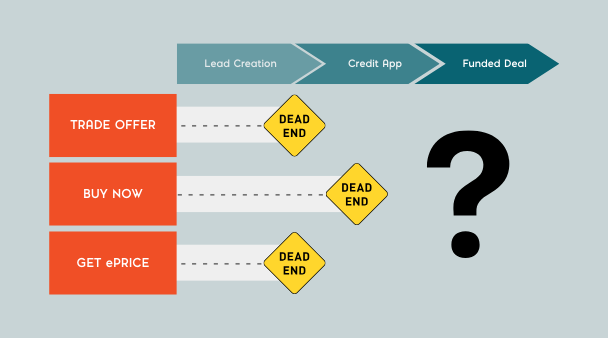Breaking the Mold: From Lead Capture to Complete Digital Retailing
Read Time 2 mins | Written by: Steve Zabawa

The automotive industry's digital landscape is evolving rapidly, yet many dealer websites remain stuck in an outdated approach. Despite a growing trend towards online car buying, most dealer websites still rely on fragmented, non-transactional call-to-actions (CTAs) that serve as mere lead capture tools rather than comprehensive digital retail solutions. This gap highlights a significant opportunity for innovation and improvement in dealer website functionalities.
The Shift Towards Online Car Buying
Recent data underscores the importance of robust digital retailing capabilities in the automotive sector:
- 38% of auto shoppers are now willing to complete the entire car purchase transaction online.
- 64% of auto shoppers are likely to conduct at least part of their next car purchase online.
These statistics indicate a clear shift in consumer behavior, emphasizing the need for dealer websites to move beyond basic lead generation.
The Problem with Current Dealer Websites
Most dealer websites suffer from a common issue: their CTAs are "one-trick ponies." They are designed primarily to capture leads, directing potential buyers to fill out forms or call the dealership. This approach is not only outdated but also fails to meet the expectations of modern consumers who seek a seamless, end-to-end online shopping experience.
Fragmented and Non-Transactional CTAs
Current CTAs on dealer websites are often:
- Fragmented: They offer isolated actions such as "Get a Quote," "Schedule a Test Drive," or "Request More Information." These actions do not contribute to a cohesive buying journey and can lead to customer frustration.
- Non-Transactional: Most CTAs do not facilitate actual transactions. They stop short of allowing customers to complete the purchase process online, which is a significant missed opportunity given the growing preference for online transactions.
The Need for Comprehensive Digital Retailing

To align with consumer expectations and capitalize on the trend towards online car buying, dealer websites need to evolve. Here are key elements that modern dealer websites should incorporate:
-
End-to-End Transactional Capabilities:
- Enable customers to complete the entire purchase process online, from selecting a vehicle to financing and finalizing the sale.
- Integrate tools for trade-in appraisals, financing approvals, and e-signature capabilities.
-
Unified Customer Journey:
- Create a seamless experience that guides the customer through each stage of the buying process without leaving the website.
- Use integrated platforms that connect inventory management, customer relationship management (CRM), and digital retailing tools.
-
Personalized Interactions:
- Leverage data to offer personalized recommendations and targeted promotions based on customer behavior and preferences.
- Implement AI-driven chatbots and virtual assistants to provide real-time support and answer customer queries.
-
Transparency and Trust:
- Provide clear and detailed information about pricing, financing options, and trade-in values.
- Display customer reviews and ratings prominently to build trust and credibility.
Conclusion
The automotive retail landscape is at a pivotal point. As more consumers embrace the convenience of online shopping, dealer websites must adapt by offering comprehensive digital retailing solutions. Moving beyond fragmented and non-transactional CTAs to a fully integrated, end-to-end online buying experience is not just an option—it's a necessity. By doing so, dealers can meet customer expectations, enhance satisfaction, and ultimately drive more sales.
For more information on how WebBuy can transform your dealership's digital retailing strategy, contact us today.